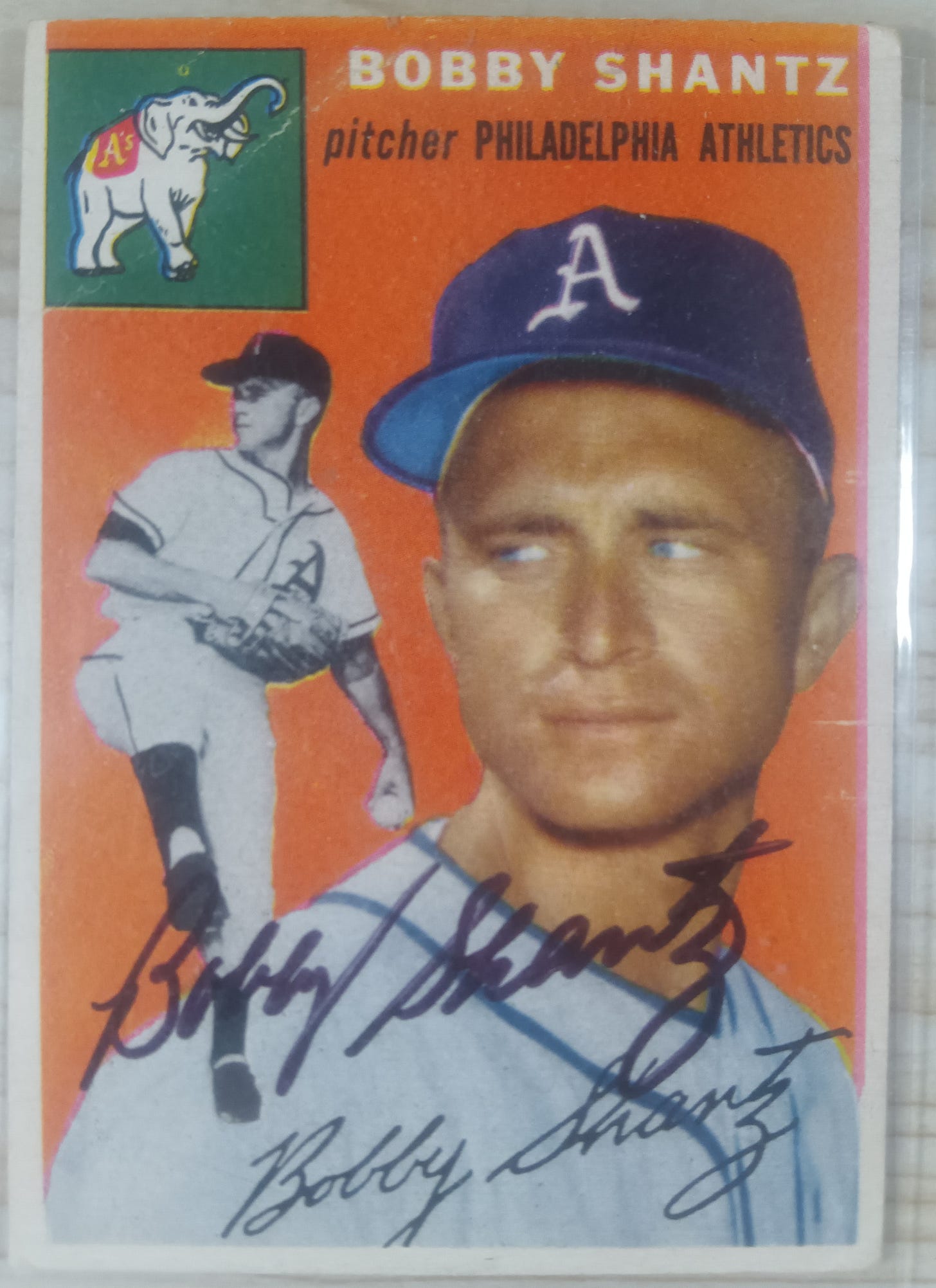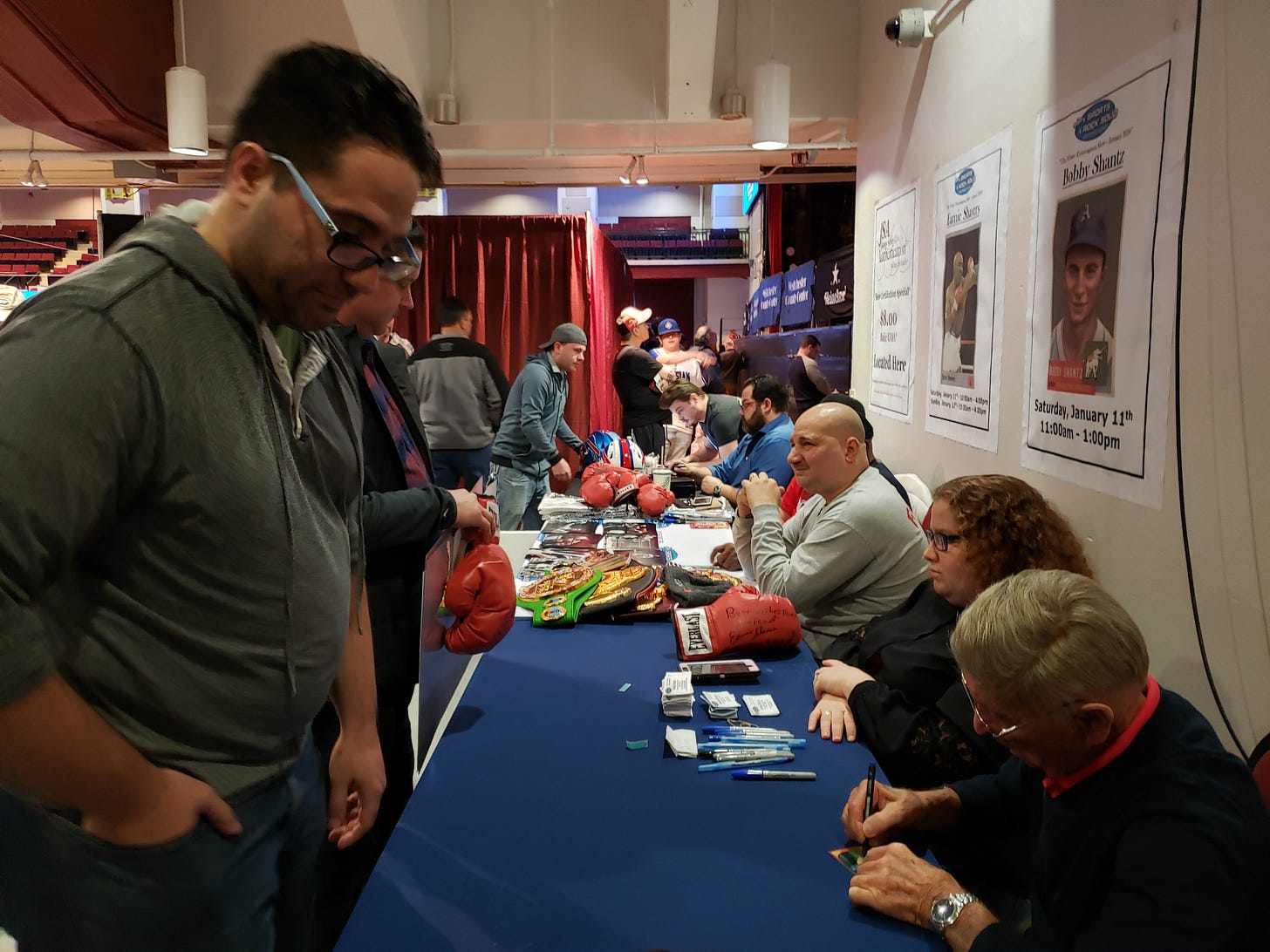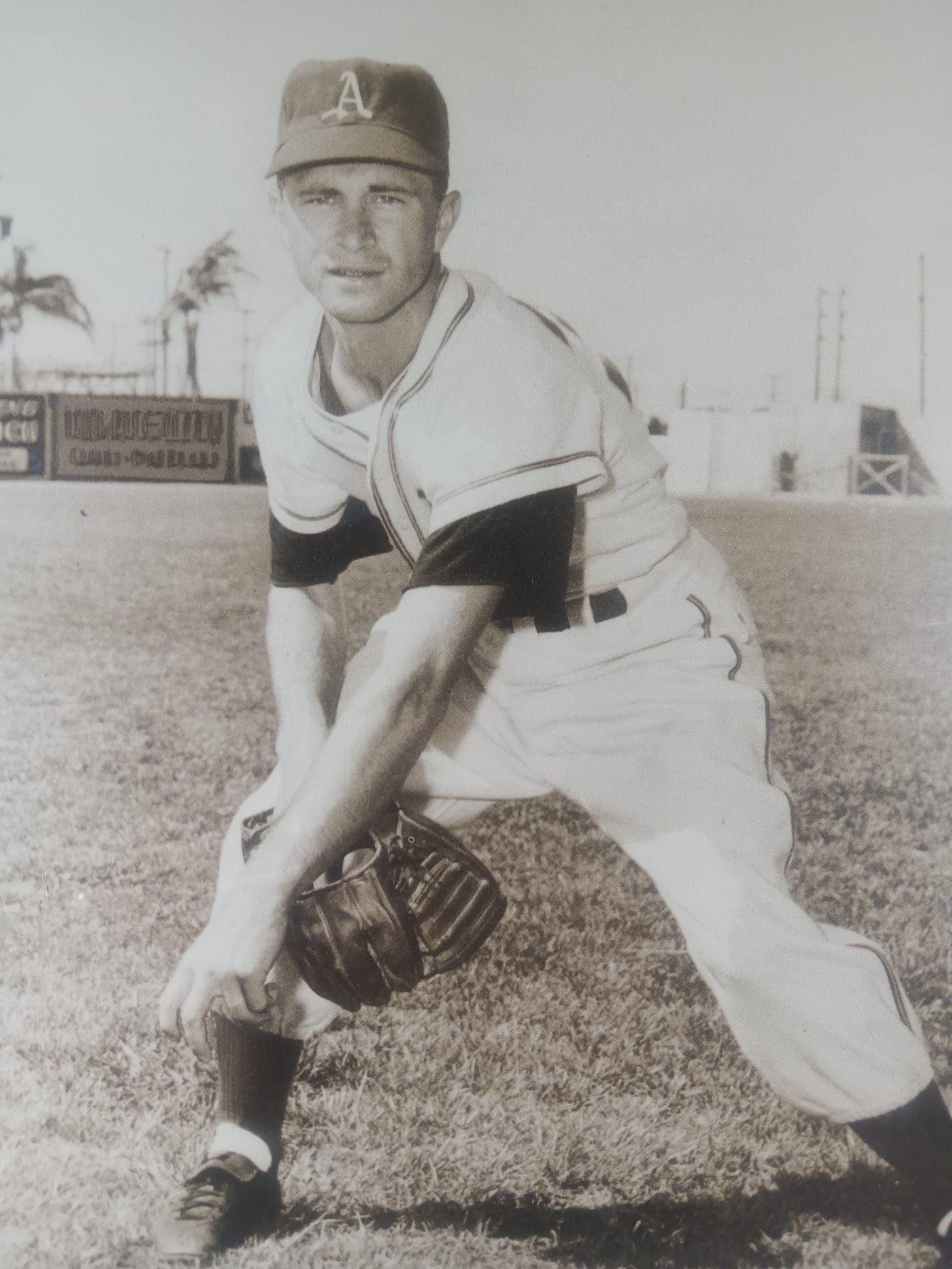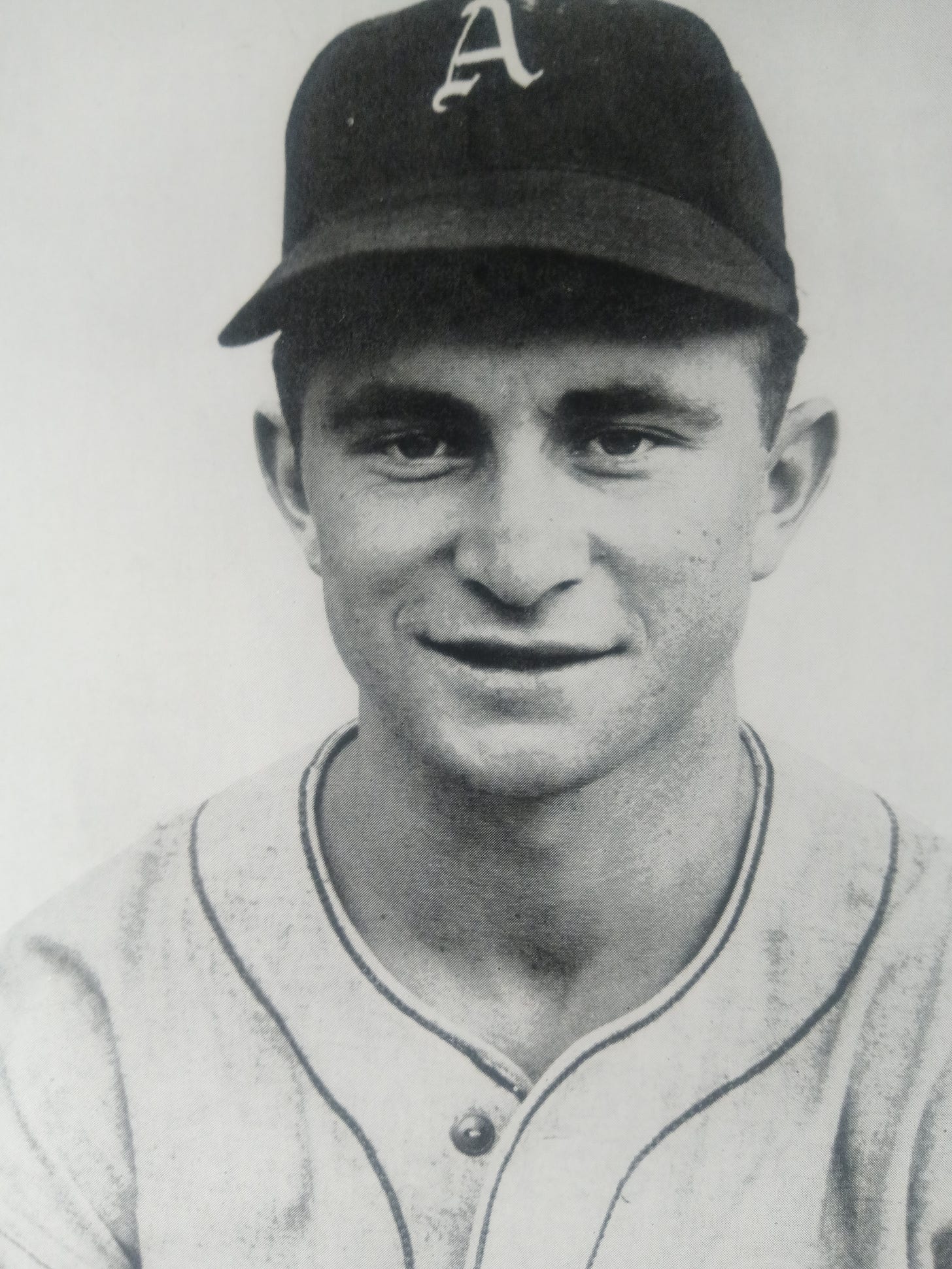Me and Bobby Shantz
Celebrating the 100th birthday for the 1952 American League MVP and one of my favorite all-time players.
A century is a long time. And a blink.
Today marks the 100th birthday for Robert Clayton Shantz, the 1952 American League MVP.
He’s the second-oldest living MLB player (after Bill Greason), the last surviving MLB player from the 1940s, the last surviving Philadelphia A’s player, and the oldest living MVP.
Bobby—who stood 5’6” in his prime—led an interesting career.
Eight Gold Gloves.
A World Series ring.
He struck out Jackie Robinson in the All-Star Game, started and won the first game played in Texas, was traded for one Hall of Famer (Lou Brock) and inspired another (Jim Kaat).
Bobby happens to be one of my favorite players.
When I was a teenager and my father was battling cancer, my father’s hospital roommate clued me into Bobby’s story. This patient grew up in 1950s Philadelphia, and he told us about his childhood self watching Bobby pitch at Shibe Park. Bobby was magical in 1952, going 24-7.
I had a reprint of Bobby’s 1954 Topps card in my baseball card collection, and I brought it with me the next day when we returned to the hospital. My dad’s roommate lit up when I gave him the card. It was a happy moment during a difficult time.
I sent Bobby a letter to share the story with him years later, along with his 1954 Topps card, and he sent me back the signed card and a kind letter in response.
“Thank you so much for the very nice letter. Very nice to hear from you. Sure is great to hear you and your Dad’s roommate heard of me. Love to hear things like you relayed to me in your letter. Thanks and best wishes to you always,” he wrote.
Fast forward to five years ago during a visit to the White Plains Card Show near where I live in New York.
The show often has a long list of signers, some of whom are free with admission.
Unbeknownst to me, Bobby was that show’s free signer. I hadn’t planned for this ... I needed to find something for Bobby to sign. I rummaged through displays of vintage baseball cards, found Bobby’s 1955 Bowman card at one of the booths, and waited in line for Bobby with my wife and young son.
After 45 minutes or so of waiting, it was finally my time.
And I was tongue-tied. Didn’t know what to say. The autograph line isn’t the best place to share a long-winded story, and every moment that passes intensifies the glares and stares of the people behind you.
“Thanks for everything Bobby, you’re the greatest,” I said.
He glanced at his younger self as he signed the card.
“This was a long time ago,” he said. Yes, I guess so.
As Bobby signed the card, he started talking to my son, who was 3 at the time. Bobby asked him his name and shook his hand, and they shared a friendly conversation.
It’s fitting that two of my connections to Bobby are through others’ childhoods.
Bobby had an interesting career. A pint-sized prep outfielder, Bobby served in the Army in World War II (he was initially rejected for military service due to his height) and was overlooked by scouts due to his size until the Athletics expressed interest. He made his major league debut in 1949.
Following his debut game, Bobby was optioned back to the minors. But before he reported to Buffalo, the club changed its mind. They called his home, but he’d already left. When Bobby arrived in Buffalo, he got a telegram ordering him to rejoin the team. He parked his car under the grandstand and took the train to Detroit to meet up with the Athletics.
A few days later, he was called on to replace starter Carl Scheib in the fourth inning. Philadelphia was down 3-1 and there was a runner on third.
No matter.
Bobby got out of the inning and kept going, matching zeroes with Tigers hurler Hal Newhouser.
The Athletics rallied in the eighth inning and tied the score following a rain delay.
Bobby kept throwing and kept getting outs. In fact, he’d pitched nine consecutive innings without giving up a hit.
Philadelphia won the game 5-4.
It was a sign of things to come. After inconsistent results in his first few seasons, Bobby came into his own in 1951, going 18-10 and making the all-star team for the first time.
And then there was 1952, when Bobby became the league’s best pitcher. At one point he strung together 11 straight wins.
One of the season’s highlights was a 14-inning thriller against the Yankees on May 30 in which Bobby held the Bronx Bombers to a single run, a solo home run by a player named Mantle.
In the All-Star Game that year, held in his home ballpark, with the rain clouds hovering, Bobby entered the game in the fifth inning to face Whitey Lockman, Jackie Robinson and Stan Musial. He struck out all of them before the skies open and the rain poured down, washing out the rest of the game.
As he wrote in his book “The Story of Bobby Shantz” with co-writer Ralph Bernstein, “My home-town fans cheered as if I had won the world series. I must admit I was a little proud of myself.”
Bobby became a national fascination that year in large part because of his height. How could this little guy be so good?
The magical MVP season came to a disappointing end on Sept. 23 when, batting against the Senators, he was hit by a pitch and broke his wrist.
Things weren’t the same for Bobby after 1952. Arm trouble limited his output in the years that followed, and the Athletics moved to Kansas City after the 1954 season.
Bobby was traded to the Yankees and spent four seasons in pinstripes before bouncing around between five different teams to end his career.
Through Bobby, the past and the future blend together.
Bobby’s first manager in the big leagues was Connie Mack, who was born in 1862, began his big league career in 1886 and started managing in 1894. His final big league manager, Gene Mauch, managed until 1987 and served as the bench coach for the 1995 Kansas City Royals.
Think about that for a second. Two men who managed the same player were in the dugout coaching players 101 years apart.
Bobby, due to his longevity, has become a torchbearer for an entire generation of players and his impact continues to carry forward.
If you play Immaculate Grid, the game that challenges you to select baseball players based on specific teams or accomplishments or categories, Bobby is one of the most useful players.
He suited up for the Athletics (in Philadelphia and Kansas City), Yankees, Pirates, Colt .45s, Cardinals, Cubs and Phillies; he won the MVP; was an all-star; won an ERA title; locked up eight Gold Gloves; and even played an inning at centerfield for the Yanks in 1958.
Friday’s grid (Athletics-Pirates) was a chance to use Bobby.
A recent grid showed Astros-Yankees (Bobby), Astros-A’s (Bobby) and Athletics MVP (Bobby) among the clues. Too bad you can only use the same player once on each grid!
Bobby has also been a steady and prolific autograph signer and enjoys signing through-the-mail autographs.
It’s difficult to quantify the sheer number of autographs he’s signed over the years.
Two hundred thousand?
Five hundred thousand?
Given the amount of years he’s been active and signing (more than 75) and the fact that he genuinely enjoys signing items, he’s probably among the most prolific signers in baseball history.
Across the years, his autograph hasn’t changed all that much.
Bobby hasn’t changed all that much, either.
A century later, Bobby is still Bobby. And that’s the long and short of it.







Hi Dan. What a captivating article. I really like your writing style. Therefore, I'm gonna check out your book lol. Thanks again for the article.
Love this story, Dan! Thank you for introducing me to Bobby. I love learning about the history of baseball and it’s nice to read about a living legend like Mr. Shantz.